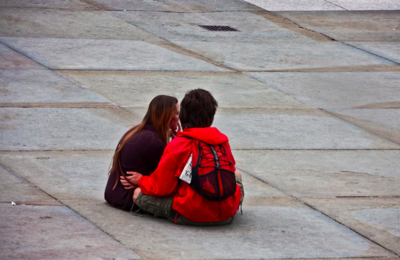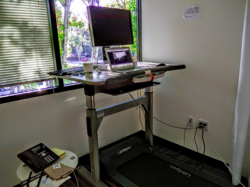
Sitting is the manner in which a human being (or other animal capable of sitting) places itself into an upright resting position. Sitting can be achieved using natural items such as the ground, a log, a tree stump or a rock. It can be achieved using a manufactured item such as a chair, beanbag, hammock, swing, stool, and so forth.
Sitting occurs frequently with such activities as using a computer, office work, studying, vehicle travel, watching television or playing video games, eating meals, socializing, reading, doing certain art and craft activities, and so forth. While unavoidable for some activities, the prolongation of sitting due to such modern activities as computer usage and television watching may be contributing to health problems, such as poor posture and increased likelihood of certain diseases. However, the act of sitting itself may not be so much the problem as the lack of movement and physical exercise that many persons who sit for prolonged periods might expose themselves to.[1]
Problems with sitting[edit | edit source]
Scientific research has found that prolonged periods of sitting in chairs may be contributing to some human health problems.[2] The health problems that long periods of inactivity resulting from sitting may include obesity, type 2 diabetes, cancer and early death (along with other contributory factors).[2] This could be linked to a reduction in metabolism, which prevents the body from properly regulating blood sugar and pressure.[2] While research into sitting is still underway and the results are not final,[1] it does make good sense to move as frequently as you can throughout the day, for the sake of your muscles, helping you to maintain good body tone and flexibility.
Finding ways to sit better or less[edit | edit source]
Sitting is inevitable for many people, both in developed and developing countries. However, for those with office jobs or for persons who spend a lot of time watching television or using computers while seated, the way of sitting and the types of chairs used might contribute to poor posture and encourage less movement. In such cases, there are ways to both change how you sit and ways to decrease the amount of time spent sitting. Include movement throughout the day; it is likely not sufficient to say that you work out at the gym for half an hour a day if you sit (don't move) for the rest of the time.[2] Aim to work in a little movement into all of your day as much as possible, change position often and do something properly active for half an hour or so, at least once during the day.
Here are some suggestions for changing how you sit:
- Sit on the floor more often. There is no support when seated on the floor, forcing you to pay attention to your posture more. This wonderful classic sitting position may also increase your humility by forcing you to see the world from lower down! As a bonus, you can play with the kids with greater ease. Most of all, you are obliged to stretch when you sit on the floor. You stretch to sit on the floor, stretch to stay comfortable there and stretch to get up from the floor. All that, without actually having to deliberately focus on stretching as some form of regimented exercise! This is great for your muscles.
- Sit on an exercise ball. The movement of the ball will cause you to move constantly, readjusting your position in order to stay upright and comfortable. It's a good idea to read more about using an exercise ball, as they require a certain level of existing strength to be comfortable and they're definitely not for everyone.
- Consider doing your computing, reading and writing work while on a sit-stand desk/treadmill. Choose a treadmill with a shelf suited to holding equipment or hack a treadmill by building your own. Experiment to find out which pace most suits you as you use the treadmill for activities (it varies for everyone and some people may not be able to concentrate at any pace). Also, be aware that not all scientists researching sitting consider this major (and potentially costly) workplace change as necessary, when what you might really need is to actually move more overall.[1] In which case, get everyone outside more often for a walk or a meeting under the trees.

A sit and stand desk on a treadmill - You could rig up a similar device for gaming and encourage teen and adult players to stand more often, potentially improving their dexterity and providing more opportunities for movement.
Here are some suggestions for changing how long you sit for:
- Break up periods of sitting with bursts of activity.[2] Clean out the filing cabinet, fridge or desk drawers. Clean the toilet. Sweep the floor. Chat to a neighbour over the fence. Water the garden. Do something active and easy. Or hard, if you prefer.
- Take regular trips to the tearoom, the water cooler, your brainstorming whiteboard.
- Find non-sitting activities to do during the day. This can be as simple as talking on the telephone while standing up, to walking home from work instead of catching the bus or train.
- Go for decent length walks whenever you get the chance. Use break times, lunch times, and after work times, to go for a walk. Walk home. Walk to the shops. Walk wherever you can. Start walking, no matter how slowly. (Do get your doctor's advice, of course, if you're unwell or in pain.)
- Hold walking meetings. Or stand under the shade of a cooling tree during a hot day. Be daring and cycle the whole team to a nice spot for a meeting, stand during the meeting, then cycle on back to work.
- Cook your own meals and make your own lunches. When you prepare your own food, you tend to do it standing up. When ordering in or eating out, there is a tendency to remain seated. That extra half an hour or so of standing while preparing food will provide more movement in your day.
- Stand to watch a half hour show of TV. If you think this is odd, consider retailers or shop owners who have the TV on as they stand and work. It's quite doable and you may find yourself wandering off during the ad breaks too, to get a cup of tea, check the kids, add to your to-do list, etc., giving you even more chances for movement.
- Play a sport, swim, go for a hike, run or jog, cycle, and so forth. Do activities that you love and that help to get you moving more often.
Sitting while outdoors[edit | edit source]
When sitting outdoors, the choice of seating is determined by where you are. Obviously, in urban environments, there will be some seating available, along with steps, stairwells, walls, posts, and other objects. Always check that you're not blocking exits or walkways when sitting on a non-chair/seat item. Apart from that, you may want to consider placing something down to protect clothing if the seated area is dirty; use a magazine, your bag or an paper bag, etc. Use clothing to create a cushion on cold or hard surfaces, such as rolling up a jacket or sweater.
When in the natural environment, enjoy the many possibilities for natural seating. Once again, consider the ground, sitting on grass for softness and a pleasant surface, or placing something down on the soil first if you don't want your clothes to get dirty. Natural surfaces and items that are good to sit on include fallen trees, tree stumps, embankments, sand, rounded pebbles, grassy knolls, etc. Always check that you're not squashing or damaging plant or animal life before sitting; avoid sitting on anything too delicate to recover from human weight being pressed against it.